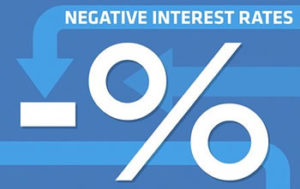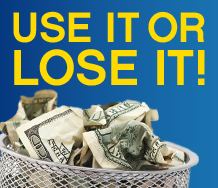 What is the key signal, for you, that we’ve arrived at End Times? Maybe war and famine? The sun turning black and the moon turning blood red? That other party’s Presidential candidate – the one you hate – might just be the Antichrist? Sure, sure, all very scary.
What is the key signal, for you, that we’ve arrived at End Times? Maybe war and famine? The sun turning black and the moon turning blood red? That other party’s Presidential candidate – the one you hate – might just be the Antichrist? Sure, sure, all very scary.
I’m a finance guy, so I’d argue: maybe negative interest rates?
The fact that trillions of dollars worth of European and Japanese debt, right now, is at a negative rate is possibly a sign of the Apocalypse. At the least it violates a clear 5,000-year-old rule: Interest rates must be positive.
Under a negative interest rate policy – snappily acronymed as NIRP and pronounced like “nerd” with a “p” at the end – banks in Europe actually have to pay the European Central Bank to hold their money. The same is true for short-term loans at the Bank of Japan, although the BOJ just announced 10-year bond rates may rise to 0 percent, aka ZIRP.
This makes 2016 a highly anomalous break with financial tradition, on a biblical scale.
Time Value of Money
Finance theory posits that money in your hand today is worth more than money in the future. We finance nerds call this the ‘time value of money’ rule. If I agree to lend you money today, you need to give me back more money in the future as compensation.
The extra money you pay me in the future, the interest, also partly accounts for the risks that:
- You wont pay me back in full and at the agreed time, and
- The depreciating rate of the value of money – what we call inflation – won’t be bigger than we expected, by the time my money gets returned to me.
We’ve always known this is just the way the world works, and this concept of time value of money, and a positive interest rate, was a totally unbreakable finance rule. Except now, in 2016! Seriously, what is happening here, people?
Now I’ll tone down the apocalyptic goofiness and argue with myself – in front of you! And for your benefit! – that in fact maybe there’s a plausible normalcy to this whole thing?
Usually loans and bonds work like this: I give you my $1,000, and at the end of the time period you pay me back my $1,000, plus some percentage extra. A 5% annual interest rate loan or bond pays me $50 interest per year, plus return of my original $1,000.
Under a negative interest rate policy when a bank stores its $1,000 of money with a Central Bank, the bank could expect to receive back – with for example a negative annual 0.25% rate – just $997.50, after one year.

This sounds ominously like a central bank is taking the private bank’s money and we shouldn’t be surprised when a NIRP increases the already considerable paranoia about the evils of central banks, quasi-governmental entities like the Federal Reserve that set monetary policy for a country. But they’re not really trying to steal money. The policy goal, from the central bank’s perspective, is to encourage holders of excess money – like banks – to spend that money on investments rather than hoard their cash.
When it comes to cash, “Use It Or Lose It!” shouts the NIRP, in the voice of your least favorite gym teacher.
With a bond offering a negative interest rate, like Germany’s 2-year bond as of this writing, you’d pay the equivalent of about $1,010 to buy the bond, receive no interest for two years, and then get your $1,000 back at the end. Hey Germany! Thanks for less than nothing, buddy!
Negative yields on bonds actually started popping up near the end of 2015. The big change this year is that bond buyers in large parts of Europe and Japan have willingly signed up for negative interest rates from the get-go. That makes financial sense only if the bond buyer expects the opposite of inflation, meaning deflation. If I expect the prices of most things to go down over the next few years, I guess I’d be willing to exchange my $1,000 today for $997.50 in the future. As long as everything’s cheaper in the future, I suppose I’m cool with less money.
Accepting negative yields also makes sense if I absolutely, positively, cannot find any reasonable riskless place to park my excess cash, which seems to be the other major problem for Japanese and European holders of excess money.
You might think, logically, that just holding your money in cash for a year would be better than one of those German or Japanese bonds, and that’s a reasonable thought. But large holders of excess money find cash eventually becomes cumbersome. Physical cash works better on a small scale than a large scale.
The size of NIRP
Speaking of large scale, how big is the negative interest rate world in 2016? It’s become a common central bank policy as well as prevalent in major (for now, non-US) bond markets.
In Japan, beginning in January 2016, the Bank of Japan declared that certain bank deposits would receive a negative 0.1 percent rate.
Switzerland, through the Swiss National Bank currently pays negative 0.75 percent on deposits, and sets a range on inter-bank lending at between negative 0.25 and negative 1.25 percent.
As of this writing, major benchmark bonds in Germany, Spain, Belgium, Netherlands, Sweden, and Italy all offer negative yields to investors.
By mid-September, the Wall Street Journal reported, debts with a negative interest rate totaled $8.3 trillion worldwide, the majority from Japan, and down from a peak amount in July of $10 Trillion.
We don’t know yet – in September 2016 – whether negative interest rates will become an odd trivia answer about this weird year, or whether they become an ordinary feature of global finance in the future.
One reason to think NIRP becomes normal-ish is that some economists have both anticipated and encouraged negative interest rates, as monetary policy, to encourage growth.
Harvard professor Kenneth Rogoff recently published a book The Curse of Cash in which he argues that negative interest rates can be, and should be, a normal tool of central banks. He’s updating the debate in real time, alongside our shifting finance reality. Controversially, to prevent physical cash hoarding. Rogoff also advocates in his book the phasing out of large-denomination bills, like $100 bills or more. NIRP works better – from an economist’s perspective – if people don’t have the chance to stuff large amounts of bills in their proverbial mattress.
Let’s make money
Meanwhile, I feel like there are a lot of people reading this who would like to borrow a lot of money at zero interest rate, and who would promise to be really careful with it.
I think all you need to do is know some Japanese banks, promise to hold their Yen safely at zero interest for a year or more, and do it for, like, many billions of dollars worth of Yen. Your zero percent offer to borrow should be so exciting for Japanese banks, as they can’t get that kind of great deal in their own country. After you arrange this multi-billion dollar deal, be sure to offer a generous referral fee to your favorite financial columnist.
If it’s End Times, I want to go out rich!
A version of this appeared in the San Antonio Express News and the Houston Chronicle.
Please see related posts:
Video – Time Value of Money
One Rate To Rule Them All – Federal Reserve Explainer
Post read (223) times.
Luca Pesaro’s Zero Alternative is a Dan Brown-style thriller, with a ruthless conspiracy of high-financiers chasing an ultra-effective prediction algorithm, a foreign-legion enforcer with a sadistic bent, a nihilistic hacker group, the chain-smoking derivatives-trading hero hoping to walk away from high finance after one last big trade, and a hot stripper who may or may not have a heart of gold (or maybe just shouldn’t be trusted.)
 Which makes this a good time to mention that Pesaro and I also went to high school together. I’m pretty sure we haven’t met up in 25 years, but our school The United World College of the American West – including the famous Montezuma Castle – makes an appearance in the crucial final fight scene of the novel. I’m guessing Pesaro hasn’t been on campus for 15 years, because he left the Castle in Zero Alternative in the unrenovated state of disrepair it was in when we attended the school, suitable only for forbidden late-night haunted-castle raids with headlamps and illegal bottles of hooch. Or maybe he has been back, and took literary license because it added to the spookiness of the scene.
Which makes this a good time to mention that Pesaro and I also went to high school together. I’m pretty sure we haven’t met up in 25 years, but our school The United World College of the American West – including the famous Montezuma Castle – makes an appearance in the crucial final fight scene of the novel. I’m guessing Pesaro hasn’t been on campus for 15 years, because he left the Castle in Zero Alternative in the unrenovated state of disrepair it was in when we attended the school, suitable only for forbidden late-night haunted-castle raids with headlamps and illegal bottles of hooch. Or maybe he has been back, and took literary license because it added to the spookiness of the scene.



